What is an upgradeable laptop? How to distinguish an upgradeable laptop from other ordinary laptops? What is modular laptop? In this post, MiniTool Partition Wizard offers you answers to these questions.
What Are Upgradeable Laptops?
When it comes to laptop upgrade, many people will think of CPU, GPU, RAM, and hard drive upgrades. Indeed, the four factors are most important in laptop upgrade. This post also focuses on them.
1. What are upgradeable laptops?
In general, as long as a laptop’s CPU, GPU, RAM, and hard drive are upgradeable, the laptop can be called an upgradeable laptop.
2. Why do you need upgradeable laptops?
The reason is simple—save money. If an upgradeable laptop can’t meet your need any more after years of usage, you can upgrade some of its hardware to boost its performance again. This will be much cheaper than buying a new high-performance PC.
I have ever seen some people ask online “Can a laptop last 10 years?” Actually, if an ordinary laptop can last for 5 to 8 years, then an upgradeable laptop may last nearly 10 to 15 years through hardware upgrade. In a word, upgradeable laptops are worth buying.
3. How to determine a laptop is upgradeable or not?
If you plan to buy an upgradeable laptop, you should note whether the laptop’s CPU or GPU is soldered. Some manufacturer will tell you this point. If the CPU or GPU is soldered on the motherboard (for example, Ultrabooks’ CPUs are usually soldered on the motherboard), this laptop is not an upgradeable laptop in a strict sense.
However, in most occasions, manufacturers won’t tell you whether this laptop’s CPU or GPU is soldered on the motherboard. If so, you can judge from the following aspects:
- Whether the laptop’s CPU can be upgraded depends on the packaging method. If the CPU on the laptop uses PGA packaging method, this CPU can be replaced. You can check the packaging method through CPU-Z.
- In terms of laptop CPUs, Intel CPU models with M letter at the end of the name are generally in PGA packages, while others are in BGA packages and soldered to the motherboard. This is another way to check the packaging method. But unfortunately, since the 4th generation, CPUs with M letter (using PGA) have never been seen again.
- If the GPU is integrated into the CPU, replacing GPU means replacing CPU.
- If the GPU is a discrete GPU and the manufacturer doesn’t tell whether it is soldered on the motherboard, you can determine that by checking its interface. If the interface is an MXM interface, it means that the GPU is not soldered. Otherwise, it is soldered and can’t be replaced at ease.
In recent years, no matter Intel or AMD, their CPUs are soldered to the motherboard and can’t be replaced easily, so I must take this situation and trend into consideration and regard these kinds of laptops as upgradeable laptops. Otherwise, there may be no real upgradeable laptops.
On the other hand, if you really want to replace the CPU soldered on the motherboard, you can still do that if you seek help from professionals. They may help you replace the CPU via BGA soldering station and other tools.
How to Upgrade Motherboard and CPU without Reinstalling Windows
4. What is a modular laptop?
As we all know, users can customize and build their own laptops. This is because various computer interfaces are standardized and modularized. However, the development of computer hardware is changing with each passing day. As a result, various CPU, GPU, RAM, and hard drive interface technical standards have been introduced.
These interface standards are incompatible with one another and users are often troubled by this issue when assembling computers. Fortunately, modular computers (they are also upgradeable computers) can solve these problems.
To put it simply, a modular computer means that each component of the computer is a module that meets certain standards. These modules can be added and removed at will, so users can realize computer upgrade easily just by purchasing and replacing specific modules.
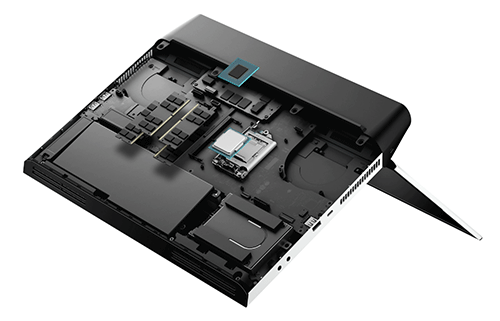
The biggest difference between a modular laptop and an ordinary upgradeable laptop lies in the interface standard and hardware architecture they support. The modular laptops use a standard designed by the manufacturer itself, while ordinary upgradeable laptops use the industry standard.
Therefore, modules of different manufacturers may not be compatible with one another. But on the other hand, as long as modules are designed by the same manufacturer, they can achieve plug-and-play upgrade without the need of considering the interface problem.
5 Best Upgradeable Laptops
1. Alienware Area 51M Gaming Laptop
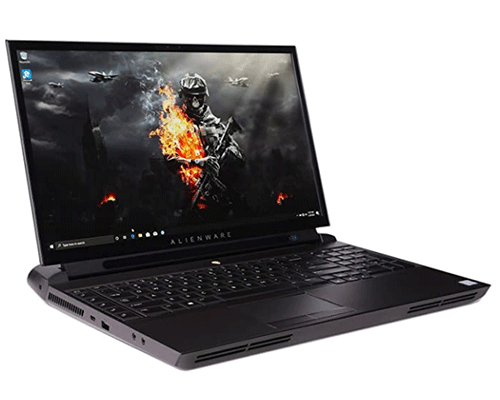
- CPU: 9th Gen Intel Core i9-9900K (8-Core, 16MB Cache, up to 5.0Ghz w/Turbo Boost).
- GPU: NVIDIA GeForce RTX 2080 8GB GDDR6 (Dedicated).
- RAM: 32GB, 64GB, or 128GB DDR4.
- Hard Drive: 1TB SSD RAID 0 (2x 512GB PCIe NVME M.2 SSDs) + 1TB (+8GB SSHD) Hybrid Drive, or 2TB RAID SSD (2x 1TB PCIe M.2 SSDs) Upgrade.
- Price: Start at $4999.
This Alienware upgradeable laptop is a modular laptop, also an upgradable gaming laptop. In addition, this laptop’s CPU, GPU, RAM, and hard drive are top-level configurations, and it comes with Windows 10 Pro 64bit OS, 1x Thunderbolt 3 port, etc.
For gamers and those who want an upgradeable laptop, Alienware Area 51M laptop can meet their needs perfectly. However, the high price and up to 4.4 kgs weight will daunt a considerable number of consumers.
2. ASUS ROG Strix Hero III Gaming Laptop 17.3”

- CPU: 9th Gen Intel Core i7-9750h Processor.
- GPU: NVIDIA GeForce RTX 2060 6GB GDDR6 (Dedicated).
- RAM: 16GB DDR4 2666MHz.
- Hard Drive: 512GB PCIe SSD.
- Price: $2258.
ASUS ROG Strix Hero laptops are well-renowned among the professional gamers and power users for its powerful performance and excellent thermal efficiency. This laptop features high quality CPU and GPU, which makes it capable of most of games. In addition, this laptop allows you to upgrade its RAM and hard drive.
3. HP Omen 17t Gaming Laptop
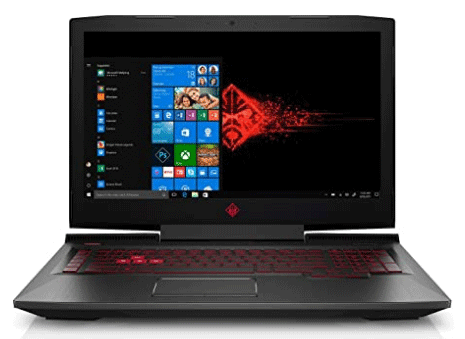
- CPU: Intel Core i7-8750H.
- GPU: NVIDIA GeForce GTX 1070 (Dedicated).
- RAM:
- Hard Drive: 128GB SSD + 1TB HDD.
- Price: $1349.
HP Omen series laptops have acquired a lot of fame among the professional gamers. Its laptops are equipped with powerful hardware and they are designed to deliver the performance to accomplish anything. Similarly, this laptop allows you to upgrade its RAM and hard drive.
4. Dell Inspiron 15 5000 FHD 1080P Touchscreen Laptop
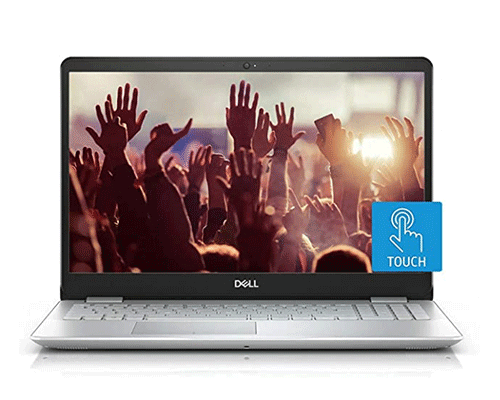
- CPU: Intel Core i7-8565U Processor (1.8 GHz base frequency, up to 4.6 GHz, 4 cores, 8M Cache).
- GPU: Intel UHD Graphics 620 (integrated).
- RAM: 8GB, 16GB, or 32GB DDR4.
- Hard Drive: 256GB SSD, 256GB SSD + 1TB HDD, 2TB SSD + 1TB HDD.
- Price: Start at $899.
The Dell Inspiron 15 is ideal for home or office users. It has the ability to use a touch screen which can come in incredibly handy if you want to lie down and work on the couch. Besides, the i7-8565U processor can offer good performance now and in the next few years, although it can’t be replaced. Of course, you can also upgrade this laptop’s RAM and hard drive as your will.
5. Acer Nitro 5 Gaming Laptop

- CPU: 9th Generation Intel Core i5-9300H Processor (Up to 4. 1GHz).
- GPU: NVIDIA GeForce GTX 1650 Graphics 4GB (Dedicated).
- RAM: 8GB DDR4 2666MHz.
- Hard Drive: 256GB PCIe NVMe SSD (2 x PCIe M. 2 Slots – 1 Slot Open for Easy Upgrades) & 1 x Available Hard Drive Bay.
- Price: $687.99.
The Acer Nitro 5 AN515-54-5812 is also a gaming laptop, although its CPU and GPU are not at the top level. This laptop allows RAM and hard drive upgrades, and its GPU still has a strong performance these days. With this GPU, you can run most games, but the game performance may not be optimized.
2020 5 Best Gaming Laptops under $1000
Tips on Laptop Upgrade
In general, laptop upgrade is always related to laptop disassembly. In this case, I recommend you to clone computer lest you do something wrong when disassembling and assembling the laptop. Cloning computer can help you recover data and system if there is something wrong.
As for computer cloning software, I recommend MiniTool Partition Wizard to you. This software is versed in disk management. Here is the tutorial:
Step 1: Click the above button to buy MiniTool Partition Wizard. Launch this tool and go to its main interface. Right click the system disk and choose Copy from the context menu (if you use this feature to clone a non-system disk, it is free).
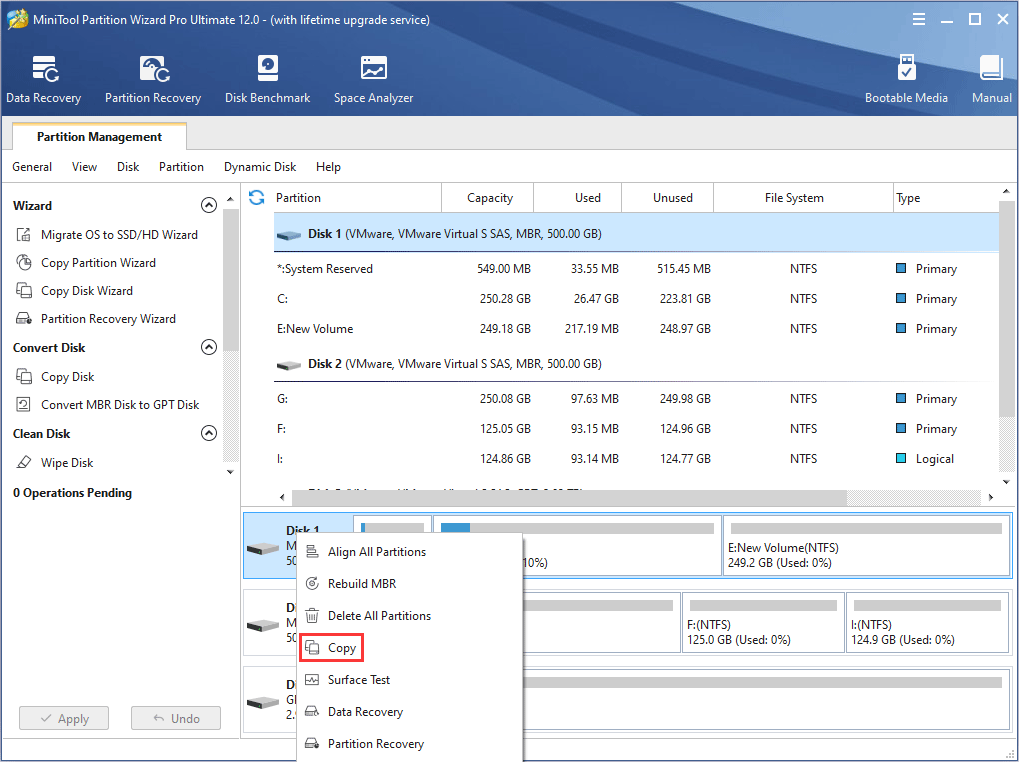
Step 2: Follow the wizard to choose a destination disk (an external disk is recommended). Please note that the data on the destination disk will be destroyed. Then, review changes and click Next button.
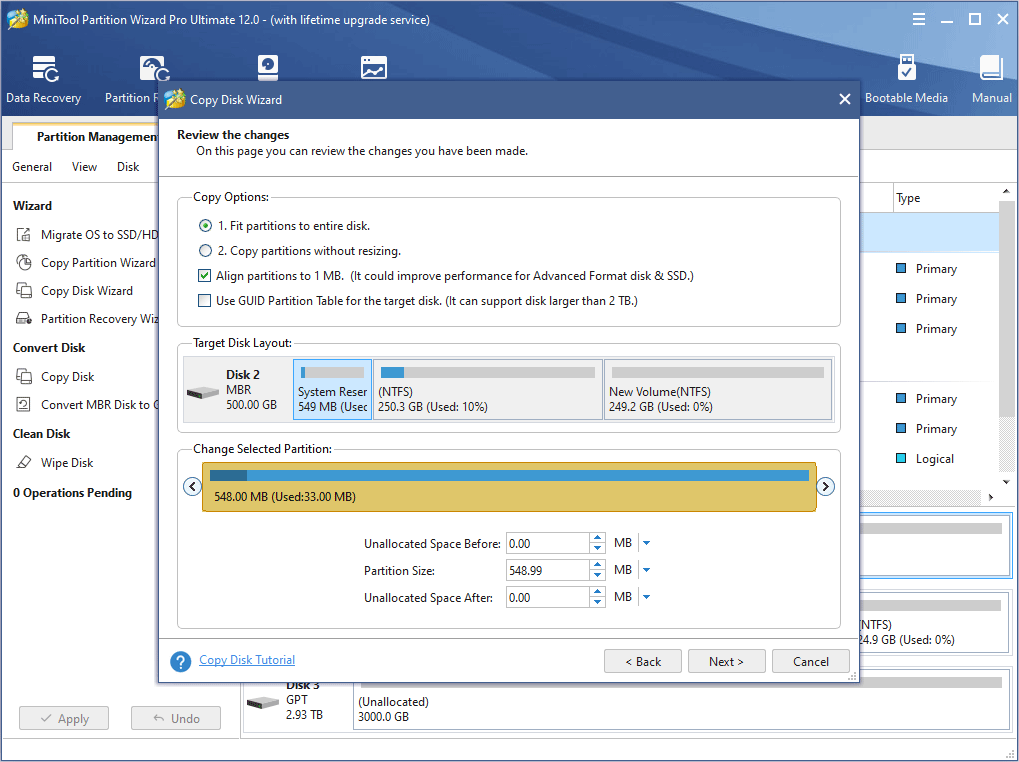
Step 3: Click the Apply button to execute pending operations.
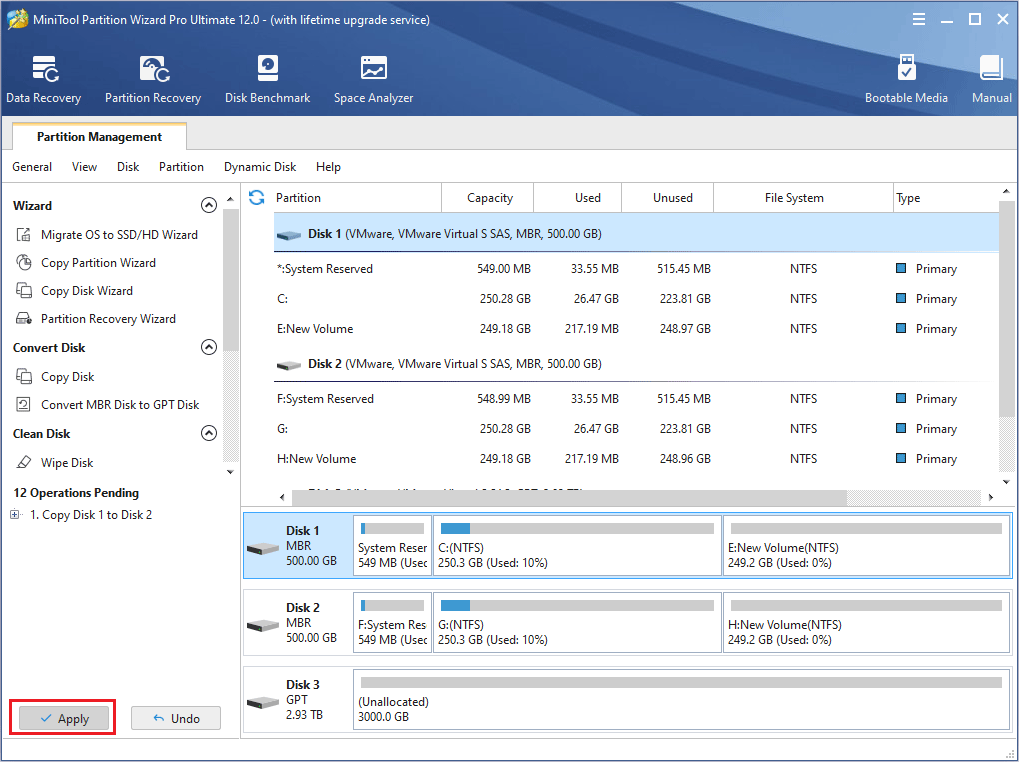
Then, you can upgrade the laptop. If the laptop goes wrong after you assembling it, you can boot it from the external hard drive and copy the system and data back to the system disk. In this way, you may rescue your laptop.
Bottom Line
Does this post solve your problem? If you still have questions about upgradeable laptops, please leave a comment below and I will answer these questions in the next update. Besides, if you know other good upgradeable laptops (modular laptops or those whose CPU and GPU are removable), please share them with us. I will appreciate that.
Finally, if you have difficulty in cloning disk, migrating OS, or managing disk and partition, please contact us via [email protected]. We will get back to you as soon as possible.
Upgradeable Laptops FAQ
This depends on the packaging method. If the CPU on the laptop uses PGA packaging method, this CPU can be upgraded. If the CPU uses BGA packaging method, it can’t be upgraded. To check the CPU’s packaging method, here are two ways for you:
- Use CPU-Z.
- If it is an Intel CPU, you can check that through its serial number. Intel CPU models with M letter at the end of the name are generally in PGA packages, while others are in BGA packages. In addition, since the 4th generation, CPUs with M letter (using PGA) have never been seen again.

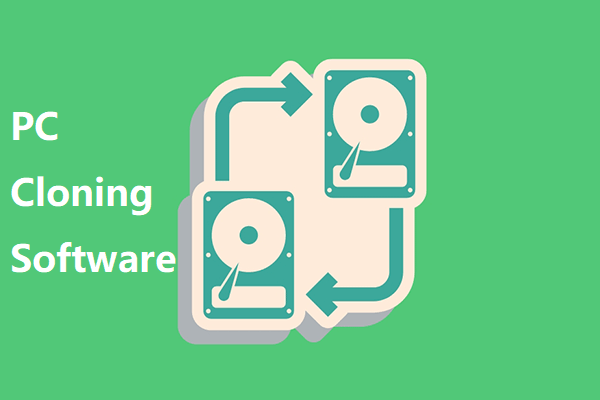
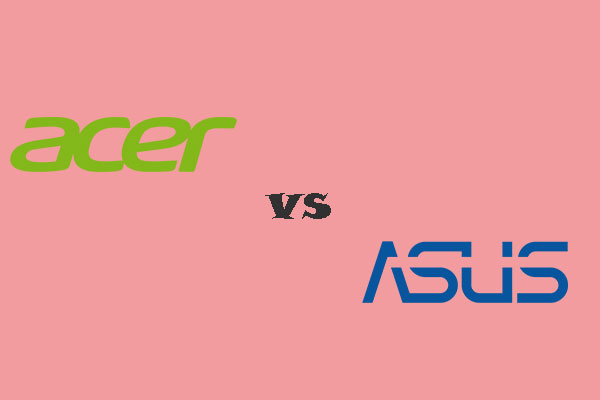

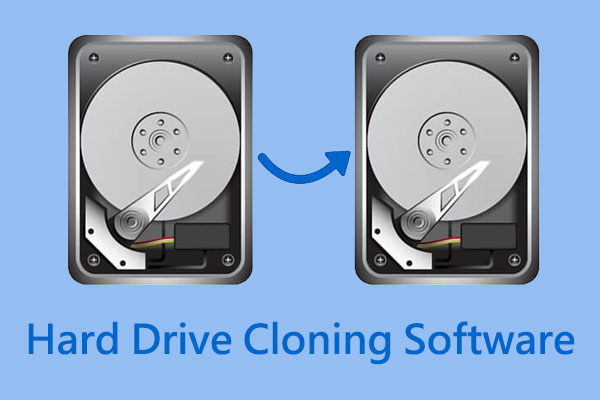
User Comments :